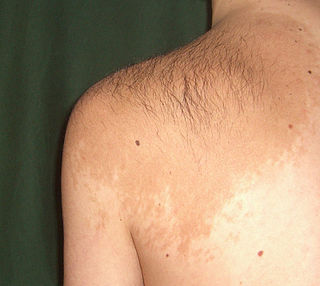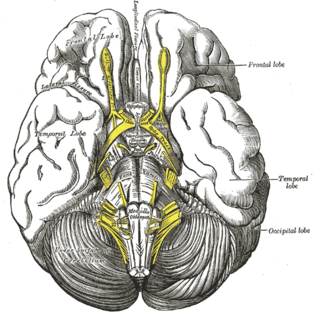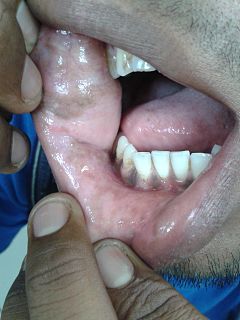
Browning is the process of food turning brown due to the chemical reactions that take place within. The process of browning is one of the chemical reactions that take place in food chemistry and represents an interesting research topic regarding health, nutrition, and food technology. Though there are many different ways food chemically changes over time, browning in particular falls into 2 main categories: enzymatic versus non-enzymatic browning processes.

The congenital melanocytic nevus is a type of melanocytic nevus found in infants at birth. This type of birthmark occurs in an estimated 1% of infants worldwide; it is located in the area of the head and neck 15% of the time.

Becker's nevus is a skin disorder predominantly affecting males. The nevus can be present at birth, but more often shows up around puberty. It generally first appears as an irregular pigmentation on the torso or upper arm, and gradually enlarges irregularly, becoming thickened and often hairy (hypertrichosis). The nevus is due to an overgrowth of the epidermis, pigment cells (melanocytes), and hair follicles. This form of nevus was first documented in 1948 by American dermatologist Samuel William Becker (1894–1964).

The interpeduncular fossa is a somewhat rhomboid-shaped area of the base of the brain, limited in front by the optic chiasma, behind by the antero-superior surface of the pons, antero-laterally by the converging optic tracts, and postero-laterally by the diverging cerebral peduncles.

Hexylresorcinol is an organic compound with local anaesthetic, antiseptic and anthelmintic properties.

Melanosis coli, also pseudomelanosis coli, is a disorder of pigmentation of the wall of the colon, often identified at the time of colonoscopy. It is benign, and may have no significant correlation with disease. The brown pigment is lipofuscin in macrophages, not melanin.
Gum depigmentation, also known as gum bleaching, is a procedure used in cosmetic dentistry to lighten or remove black spots or patches on the gums consisting of melanin. Melanin in skin is very common in inhabitants in many parts of the world due to genetic factors. Melanin pigmentation in skin, oral mucosa, inner ear and other organs is a detoxification mechanism. Some toxic agents bind to melanin and will move out of the tissue with the ageing cells and are expelled to the tissue surfaces. Also in the gums and oral mucosa a visible pigmentation is most often caused by genetic factors, but also by tobacco smoking or in a few cases by long-term use of certain medications. If smoking stop or change of medication do not solv the problem with a disfigurating melanin pigmentation, a surgical operation may be performed. The procedure itself can involve a laser ablation techniques.

Transient neonatal pustular melanosis is a cutaneous condition that presents at birth with 1- to 3-mm flaccid, superficial fragile pustules, some of which may have already resolved in utero, leaving pigmented macules.
Riehl melanosis is a form of contact dermatitis, beginning with pruritus, erythema, and pigmentation that gradually spreads which, after reaching a certain extent, becomes stationary. The pathogenesis of Riehl melanosis is believed to be sun exposure following the use of some perfumes or creams.
Tar melanosis is an occupational dermatosis that occurs among tar handlers after several years of exposure, characterized by a severe widespread itching that is soon followed by the appearance of reticular pigmentation, telangiectases, and a shiny appearance of the skin.
Oral pigmentation is asymptomatic and does not usually cause any alteration to the texture or thickness of the affected area. The colour can be uniform or speckled and can appear solitary or as multiple lesions. Depending on the site, depth, and quantity of pigment, the appearance can vary considerably.
Phylloid hypomelanosis is a cutaneous condition, a syndrome occurring in patients with mosaic trisomy 13 or translocation trisomy 13.
Progressive macular hypomelanosis is a common skin condition, a disorder, observed more frequently in young women with darkly pigmented skin who originate from or reside in tropical climates.
Laugier–Hunziker syndrome is a cutaneous condition characterized by hyperpigmentation of the oral mucosa, longitudinal melanonychia, and genital melanosis.
Neurocutaneous melanosis is a congenital disorder characterized by the presence of congenital melanocytic nevi on the skin and melanocytic tumors in the leptomeninges of the central nervous system. These lesions may occur in the amygdala, cerebellum, cerebrum, pons, and spinal cord of patients. Although typically asymptomatic, malignancy occurs in the form of leptomeningeal melanoma in over half of patients. Regardless of the presence of malignancy, patients with symptomatic neurocutaneous melanosis generally have a poor prognosis with few treatment options. The pathogenesis of neurocutaneous melanosis is believed to be related to the abnormal postzygotic development of melanoblasts and mutations of the NRAS gene.










